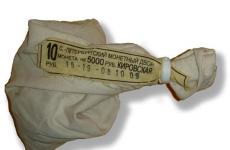The world's first tram. History of the tram - Mollenta - Youth information portal
How and where did this type of urban transport appear?
The tram is the most poetic and romantic form of transport; it is mentioned in hundreds of songs, books, and poems. May 21 marks the anniversary of the launch of the very first tram in our country, so it’s time for us to talk about it.
The ancestor of the tram was the so-called “horse tram” - a city railway along which horse-drawn carriages moved. They appeared in the USA in the first half of the 19th century, spread throughout all developed countries of the world and existed until the beginning of the 20th century, when horse-drawn trams were replaced by electric ones. In Mexico, horsecars operated until 1956, and on the British Isle of Man they can still be seen today, although no longer as regular transport, but as a tool to attract tourists.
In addition to horse-drawn cars, before the invention of trams, there were other types of rail urban transport: steam, cable, pneumatic, gas-powered, etc. But the real heyday of the tram era came only after they began to run on electricity. The theoretical basis for the functioning of electric transport was created by V. N. Chikalev, B. S. Jacobi, D. A. Lochinov and P. N. Yablochkov back in 1838, but it was put into practice only four decades later. Since 1876, the Russian scientist Fyodor Apollonovich Pirotsky has been testing the movement of cars using electric traction and was even able to “move” the train along the rails in 1880, but did not complete his experiment. Therefore, Werner von Siemens from Germany, who patented it, is considered the actual inventor of the tram. The first tram ran along the railway line between Berlin and Lichterfeld in 1881, at the same time the first tram line appeared in Paris.
The first tram in the Russian Empire was launched in 1892 in Kyiv. The machine is manufactured by Siemens. Then tram lines appeared in Nizhny Novgorod, Yekaterinburg, Vitebsk, Kursk, Moscow, Kazan, Tver. In 1907, a tram appeared in the capital, St. Petersburg.
Until World War II, the tram was the main form of public transport in all developed cities of the world. Existing tram lines were constantly expanded, and new routes were opened. But gradually the tram began to be replaced from city streets by other modes of transport.
Trams moved to the periphery of urban transport in the late 1950s. By this time, cars had ceased to be a luxury; technological progress had significantly increased the reliability and efficiency of trolleybuses and buses. For the latter, there was no need to lay rails and build complex depots, so they were increasingly released onto city streets instead of trams. In some countries, such as France or Great Britain, trams have disappeared almost completely.
In the USSR, and then Russia, trams, even during the decline of their popularity, remained extremely in demand. In socialist countries, the population did not acquire personal cars as quickly as in the West, so public transport flourished.
Today trams are coming back into fashion. The world community has long been concerned about the problem of environmental pollution, and trams, like trolleybuses, are environmentally friendly transport and do not emit harmful emissions into the atmosphere, like cars or buses. Therefore, many countries where trams remained in one or two cities are now planning to resume active tram traffic.
Interesting facts about trams
The most “tram” city is St. Petersburg. The length of tram tracks in the Northern capital is 220 kilometers, which was recorded in the Guinness Book of Records. Melbourne can also be called the “capital of trams”, as it has the largest network of this type of transport.
The longest tram route is the Coastal Tram in Belgium. Its length is 67 kilometers. On which trams make 60 stops. There is also a 185 km line from Freudenstadt to Ohringen.
"DIVO" Russian book of records and achievements
HUMAN ACTIVITY: Science and Technology:Public transport
PUBLIC TRANSPORT
RUSSIAN HORSE
In Russia, a horse tram appeared in St. Petersburg in 1860, first as a freight train, connecting the 17th line of Vasilyevskaya: the islands with the stock exchange warehouses. And in 1866, three passenger lines began operating - Nevskaya, Admiralteyskaya and Sadovaya. In 1872, the first horse tram line was built in Moscow. In the early 1880s, horse tram lines were in Odessa, Kharkov, Tiflis, Riga and Rostov-on-Don.
FIRST TRAM
The first tram in Russia appeared in St. Petersburg. On August 22, 1880, at 2 p.m. on Peski, at the corner of Bolotnaya Street and Degtyarny Lane, Russian inventor Fyodor Apollonovich Pirotsky demonstrated the first electric tram. Pirotsky, an employee of the Main Artillery Directorate, solved the problem of transmitting electricity along rails. Later, on an abandoned railway line in Sestroretsk, he managed to move a tram along the rails, located a kilometer away from the power source. The owners of joint-stock companies of horse-drawn railways saw a dangerous competitor in the electric carriage. Therefore, Pirotsky, unfortunately, did not go further than experiments. And only 12 years later (in 1892) tram traffic began in Kyiv. The length of the first branch was 1.6 kilometers. Then tram lines were built in Nizhny Novgorod, Kazan, and Yekaterinoslav.
In 1883, for the first time, a tram was powered through an overhead contact wire, like modern trams.
In Moscow, the first trams appeared in1899 And in St. Petersburg only in 1907, that is, 27 years after and inventions.
FIRST TAXI
The first taxi car appeared on the streets of St. Petersburg in 1907. And in Moscow, the first taxis - French Renaults and Italian Fiats - ran around on June 21, 1925. It was only in 1932 that domestic GAZ-A6 cars appeared in taxis, and since 1936 - M-1 cars (the famous “emkas”).
FIRST MOSCOW BUS
The first bus began operating in Moscow on April 18, 1922. The cost of a ticket “for one station” was a quarter of a million paper rubles. The entire flight consisted of two stations. The first bus did not have its own number or any specific schedule. It was possible to “capture” the bus and board it only by chance.
Regular bus service opened in Moscow on August 24, 1924. A total of 8 cars from the English company Leyland were in service, which could reach a maximum speed of 30 kilometers per hour.
FIRST TROLLEYBUS
The first Russian trolleybus was created in 1933 at the Moscow Dynamo plant. On November 1933, a lot of people gathered on the square of the Belorussky Station. Everyone was looking towards the Leningradskoye Highway. Soon a “horned one” appeared on the road, returning from his first trip from the Belorussky station to the village of Vsekhsvyatskoye.
FIRST METRO
The first project for the construction of the Moscow metro - the “off-street railway”, as it was then called, was developed by the Russian engineer P. I. Balinsky and at the end of 1902 was considered in the Moscow City Duma. It immediately aroused a wary attitude towards itself: after all, it provided for the gratuitous alienation of urban lands around the ground lines and the demolition of many houses. Shareholders of tram companies were afraid of competition, the clergy dubbed the subway a “sinful dream,” and the project was rejected. A few years earlier, the project to build a metro in St. Petersburg was rejected in the same way.
The first metro in our country was opened in Moscow in May 193S. The first stage was 11.6 kilometers long and had 13 stations (two lines - from Sokolniki to the Gorky Central Park and to Smolenskaya Square). On these lines, 15 pairs of four-car trains ran per hour, carrying 177 thousand passengers per day.
METRO RECORDS
The busiest metro in the world is in Moscow. Every day its services are used by 8 to 10 million people. In May 1990, the Moscow Metro had 141 stations, 49 interchange hubs, and 428 trains that ran along 227 kilometers of track. Ranking fifth in the world in terms of development of the railway network, the Moscow metro firmly holds the palm in terms of the number of passengers transported per day.
INSTEAD OF BUSES - FUNICULARS
The largest number of cable cars is in the Georgian city of Chiatura. There is nothing like it anywhere in the world. Cable cars are the main mode of transport here: dozens of lines connect the city center with mines and workers' villages. Some of them are passenger ones.
NORTHERNEST TRAM
The closest tram line to the North Pole is in Ust-Ilimsk, 16 kilometers long. Since 1991, the world's northernmost tram has been running along it. A tram line connects the city with the forest complex.
Alexandrovsky descent in Kyiv
First electric tram
On May 2, 1892, the first electric tram was launched in the Russian Empire.
This happened in Kyiv on the former Aleksandrovsky Spusk (now Vladimirsky Spusk). Interestingly, the tram in Kyiv was built almost 20 years earlier than in Moscow and St. Petersburg. Until this moment, there were trams in Tsarist Russia, but they were “moved” not by electricity, but by horses. Although also on rails.

In general, iron rails at that time were laid in many cities around the world, horse-drawn rail trams were common, there were also attempts to build civilian transport powered by steam, but due to discomfort and the abundance of smoke, this idea was discarded in favor of electricity. The world's first electric tram was built in Berlin in the early 1880s, built by Siemens - its brand is still well known today.
The Russian Empire followed the example of the Germans, and soon the German Pullman plant produced the first Russian electric tram.
Civil transport in Kyiv, as in most European cities, began with a horse-drawn tram on rails, the routes of which connected the current Lybidskaya metro area with Khreshchatyk and stretched further to Podol.

The city railway society, formed in 1891, with the support of the city authorities, decided to use electric traction on the Aleksandrovsky Descent section. Considering that there is a very sharp slope of the mountain here, there were no other options: the horses could not cope and steam traction was out of the question. It was the complex nature of Kyiv’s terrain that led to the need for more powerful and safe electric urban transport.
From the very moment of its inception, the Kiev electric tram was a curiosity and one of the city’s attractions. Most visitors and guests tried to ride the tram several times, and as a commercial enterprise, the tram turned out to be extremely profitable and recouped all investments during the first year of existence.

The rapid development of the tram in Kyiv led to the fact that at the beginning of 1913 the city already had more than twenty permanent tram routes. At that time, all tram transport came into the possession of one Belgian company, which saw it only as a source of profit and did nothing for development. In this regard, the city authorities in 1915 declared their right to buy out the enterprise, after which bidding began: the Belgians inflated the price, the city duma underestimated. Numerous commissions and courts postponed the deal, and then came 1917, revolution and civil war.
The Belgians were left with nothing, and the tram service was restored only in 1922, and until the Great Patriotic War, the tram was the main type of civilian transport in Kyiv. After the war and the reconstruction of the city, the importance of the tram slowly but steadily declined. More comfortable trolleybuses, buses and subways have appeared.

The Kiev tram functioned even under the Germans - both in 1918 and in 1941-43.
Currently, the Kiev tram has lost its former importance, the planned dismantling of most lines is taking place, as a result of which only a few routes that are most in demand by passengers will remain: the line to Pushcha - Voditsa, the high-speed line to Borshchagovka.
Today, a tourist tram route operates in Kyiv - along the embankment, Podol in a restored tram car - an original and popular type of excursion.

In 1992, a monument to the first tram was erected on Poshtova Square in Kyiv, but on November 25, 2012 it was eliminated due to the construction of a new transport interchange.
History of the Moscow tram
Brest Station Square in Moscow
On April 7, 1899, the first electric tram was launched in Moscow
On March 25, old style, from the Brest, now Belorussky station, towards the Butyrsky station, now called Savelovsky, a tram car ordered in Germany from Siemens and Halske set off on its first passenger trip.

Tram at Butyrskaya Zastava. 1900
The year of the appearance of public passenger transport in Moscow should be considered 1847, when the movement of ten-seat summer and winter carriages along 4 radial lines and one diametrical was opened. From Red Square it became possible to travel by carriage to the Smolensky market, Pokrovsky (now Elektrozavodsky) bridge. Rogozhskaya and Krestovskaya outposts. Along the center line it was possible to travel in carriages from the Kaluga Gate through the city center to the Tverskaya Zastava.
Muscovites began to colloquially call crews plying in predetermined directions “lines.” By this time, the city already had about 337 thousand inhabitants and the need arose to organize public transport. The Moscow Line Society, created in 1850, began to solve the problem of serving passengers more efficiently. The line accommodated 10-14 people, there were 4-5 benches. They were wider than ordinary carriages, had a roof against the rain, and were usually pulled by 3-4 horses.

Horse-drawn horse on Serpukhov Square
The first passenger line of the horse-drawn tram was opened on June 25 (July 7), 1872. It connected the city center (present-day Revolution Square) through Trubnaya and Strastnaya Square with the square of the Smolensky (now Belorussky) station and was intended to serve visitors to the Polytechnic Exhibition, which opened on this time in Moscow. The horse-drawn line was single-track, had a length of 4.5 km with a gauge of 1524 mm, and there were 9 sidings on the line. The line operated 10 double-decker carriages with imperials, accessed by steep spiral staircases. The Imperial did not have a canopy and passengers, sitting on benches, were not protected from snow and rain. The horse-drawn carriages were purchased in England, where they were produced at the Starbeck plant. The peculiarity of this horse-drawn railway line was that it was built by military builders as a temporary one.

Steam engine
At the same time, a steam passenger tram line was built in Moscow from Petrovsko-Razumovsky through the Petrovskaya Academy Park to the Smolensky railway station. Both lines were supposed to cease to exist immediately after the closure of the Polytechnic Exhibition, but Muscovites liked the new public transport: traveling from the center to the Smolensky station was more convenient and cheaper in a horse-drawn tram than in a cab. The first passenger horse-drawn line continued to operate after the closure of the Polytechnic Exhibition until 1874, and the steam passenger tram line maintained its existence only on the section from Smolensky Station to Petrovsky Park.
Contrary to popular belief, the launch of the tram was not a simple electrification of the horse-drawn tram, which had existed in Moscow since 1872. Until 1912, the horsecar existed parallel to the tram. The fact is that the horse tram brought a significant portion of revenue to the city treasury, and the then city authorities considered the tram as a competitor to their cash cow. Only in 1910 the city began to buy out the horse-drawn railways while preserving the jobs of the horsemen. Coachmen were retrained to become carriage drivers, and conductors, who did not need to be retrained, remained conductors.

Type F tram on the Garden Ring in the Red Gate area opposite Afremov’s house. October 1917.
In 1918, the length of tram tracks in the city was 323 km. However, this year for the Moscow tram began with the fact that the number of tram routes began to decrease. Unsettled workshops, lack of parts and spare parts, materials, departure of some engineering and technical workers - all this together created an extremely difficult situation. The number of carriages entering the line in January decreased to 200 units.
The number of tram employees decreased from 16,475 people in January 1917 to 7,960 people in January 1919. In 1919, passenger tram traffic was suspended from February 12 to April 16 and from November 12 to December 1 due to lack of fuel in the city. At the end of December, the tram in the city was stopped again. The workers freed up in this case were sent to work on clearing paths and roads and for storing fuel within the eight-mile strip.
At the same time, for the first time in history, the Moscow tram began to be used for cultural, educational and propaganda events. On May 1, 1919, tram trains with flying circus performances on open trailer cars ran on routes A and B, No. 4. The motor carriage was turned into a room for a religious orchestra, and on the trailer freight platform there were circus performers, acrobats, clowns, jugglers and athletes who gave performances at stops. The masses of people enthusiastically greeted the artists.

Interior of a KM type car - the first Soviet tram
On June 1, 1919, the City Railways Administration, by order of the Moscow City Council, began to provide trams for excursions outside the city for workers at the request of institutions and organizations. Since the fall of 1919, the tram has become the main carrier of firewood, food and other goods for most city institutions. In order to provide new functions for the tram, access tram tracks were built to all freight stations, wood and food warehouses in Moscow. According to orders from enterprises and organizations, tram operators provided up to 300 freight tram cars. In 1919, about 17 miles of new tracks were laid to resolve issues of organizing freight transportation. By the end of 1919, 778 motor and 362 trailer cars, 66 motor cars and 110 trailer tram cars were operational.

KM type tram on Krasnoprudnaya street in 1970. To his right is moving in the opposite direction Trolleybus ZiU-5 .
In 1920, tram travel became free for workers, but due to a shortage of rolling stock, the Moscow City Council was forced to organize special passenger block trains to transport workers to and from work during morning and evening rush hours.
Tram trains ran on eight letter routes. They were used mainly by workers in large factories. In December 1920, there were 777 motor and 309 trailed passenger cars in inventory. At the same time, 571 motor and 289 trailed tram cars were inactive.
In October 1921, all departments of the Moscow tram were again transferred to commercial self-sufficiency, which made it possible to significantly increase the number of workers on the Moscow tram; in 1922 there were already more than 10,000 workers.
The production of passenger cars grew rapidly. If in March 1922 only 61 passenger cars were produced on the line, then in December their number was 265 units.
On January 1, 1922, the issuance of free travel tickets for workers was stopped. The amounts allocated by enterprises for free travel for their workers and employees were included in their wages, and from that time on, city transport became paid for all passengers.

Interior of the Tatra-T2 carriage: ticket office
In February 1922, passenger tram service was carried out on thirteen tram routes, and it again became regular.
In the spring of 1922, traffic began to be actively restored on the pre-war networks: to Maryina Roshcha, to the Kaluga Outpost, to the Sparrow Hills, along the entire Garden Ring, to Dorogomilovo. In the summer of 1922, the steam tram line from Butyrskaya Zastava to Petrovsko-Razumovsky was electrified, and a line was built from the Petrovsky Palace to the village of Vsekhsvyatskoye.
By 1926, the length of the tracks had increased to 395 km. In 1918, 475 carriages carried passengers, and in 1926, 764 carriages. The average speed of trams increased from 7 km/h in 1918 to 12 km/h in 1926. Since 1926 he began to go on line first soviet tram type KM, built at the Kolomna Locomotive Plant. The KM differed from its predecessors in its four-axle design.
The Moscow tram reached its highest point of development in 1934. Then he walked not only along the Boulevard Ring, but also along the Garden Ring. The latter was served by tram route B, which was later replaced by the trolleybus route of the same name. The tram then transported 2.6 million people per day per day, with a city population of about four million. Freight trams continued to operate, transporting firewood, coal and kerosene throughout the city.

The M-38 tram had a very futuristic appearance.
Before the war, a rather futuristic-looking tram appeared in Moscow M-38. The first example of a tram car M-38 arrived from the Mytishchi plant in November 1938 to the tram depot named after. Bauman and began testing on route 17 from Rostokin to Trubnaya Square.
In July 1940, due to the threat of war, the entire country switched to an eight-hour working day and a six-day working week. This circumstance forever determined the operating mode of tram trains in the capital. The first cars began work on the route at 5:30 a.m. and finished work at 2 a.m. This work schedule has survived to this day.
After the opening of the first metro lines in the mid-1930s, the tram lines coinciding with the metro lines were removed. Lines from the northern and western parts of the Garden Ring were also moved to secondary streets.
More radical changes took place in the 1940s, when tram routes were replaced by trolleybus routes in the western part of the Boulevard Ring and moved away from the Kremlin. With the development of the metro in the 1950s, some of the lines leading to the outskirts were closed.

Tram MTV-82
Since 1947, MTV-82 cars appeared on the lines, the body of which was unified with the MTB-82 trolleybus. The first such cars arrived at the Bauman depot in 1947 and began to operate first on route 25 (Trubnaya Square - Rostokino), and then on route 52. However, due to its wider dimensions and the absence of characteristic beveled corners (after all, the tram cabin exactly corresponded to the trolleybus), the car did not fit into many curves and could only run in the same place as the M-38 car. For this reason, all cars of this series were operated only at the Bauman depot and were nicknamed broadheaded. Already next year, they began to be replaced by a modernized version of the MTV-82A. . the carriage was lengthened by one additional standard window section (roughly speaking, it became longer by one window), and its capacity increased from 120 (55 seats) to 140 (40 seats). Since 1949, the production of these trams was transferred to the Riga Carriage Works, which produced them under the old MTV-82 index until mid-1961.

Tatra-T2
March 13, 1959 at the depot named after. The first Czechoslovak four-axle motor car T-2 arrived in Apakov, which was assigned number 301. Until 1962, T-2 cars arrived exclusively at the Apakov depot, and by the beginning of 1962 there were already 117 of them - more than were purchased by any city in the world . Incoming cars were assigned numbers three and four hundred. The new cars were sent primarily to routes 14, 26 and 22.
Since 1960, the first 20 RVZ-6 cars arrived in Moscow. They arrived at the Apakovskoe depot and were used until 1966, after which they were transferred to other cities.

Tram RVZ-6 on Shabolovka, 1961
Since the mid-1990s, a new wave of tram line removal began. In 1995, the line along Prospekt Mira was closed, then at Nizhnyaya Maslovka. In 2004, due to the upcoming reconstruction of Leningradka, traffic along Leningradsky Prospekt was closed, and on June 28, 2008, the line on Lesnaya Street, where routes 7 and 19 ran, was closed. It was this section that was part of the very first line of the Moscow electric tram.
.jpg)
The world's first tram was represented by a horse-drawn carriage, which was a large, covered, high carriage, with benches for seats on its roof. Such an engineering structure followed along city streets along rail tracks, usually horse-drawn. The American city of Baltimore, USA became a pioneer in the development of such technology in 1828. Four years later, the city of New York becomes the owner of the same horse-drawn horses, and four years later, the third American city of New Orleans gets the miracle of the nineteenth century horse-drawn horses. But this passenger mode of transport reached its greatest popularity twenty years later. Namely, in 1852, end rails of a new form appeared.
If previously they protruded fifteen centimeters above the street level of the road surface, now they, on the contrary, went deeper into the city road surface. They had a groove, which engaged the wheel flanges. The authorship belonged to the French inventor Alphonse Loubet. Thus, there is less interference for urban transport. Horse traction in the form of one or two horses could be replaced by zebras or mules.
The main advantage of horse-drawn carriages compared to omnibuses was the lowest rolling resistance. Experts continued to work on improving this type of transport, since living traction power could only work for four, maximum five hours. Then the animals required either replacement or complete rest. To provide just one tram car, ten units of one or another type of animal were required. They had to be provided not only with rest, but also with food. All this increased overhead costs.
These first trams existed practically until 1914. By that time, electric traction was striding across the earth in full force, and it was this that helped replace the hard work of animals. The same American city of New York was in the lead in equipping the first electric trams. In the same year, they began to abandon the further use of horse-drawn horses. True, in the European city of Amsterdam there were curious cases when the same horse-drawn tram continued to be used, but a bus was used as the traction force. To make such an innovation clear to the local working people, stencils with a bright inscription “tram” were installed on such vehicles. This type of transport existed in Amsterdam for four years. After which, the tram tracks were dismantled, and city buses began to run along the streets.
Great Britain is a country with strict rules. On its territory, laws that appeared in the twelfth or thirteenth century are still in force. So the tramcar, where traction is carried out by mules, still remains on the British Isle of Man. The horse-drawn horse disappeared from the streets of the Mexican city of Zelaya only in 1956.
The Americans tried to replace electric trams with small steam locomotives. But this innovation did not take root due to a lot of noise and black smoke.
The tram, created in 1880 using cable traction, is still very popular in San Francisco, America. The rope itself runs along a gutter; a steam engine was initially used as traction; later, an electric motor was used. This tram has no speed control. Today, this cable tram is one of the popular vacation spots not only for young people, but also for older people.
At the end of the nineteenth century, Parisians were able to use the services of a pneumatic tram on the streets of the capital. For this purpose, the city created an entire pneumatic network. The city compressor station supplied compressed air through pipes as traction force. The movement of the tram car was driven by a pneumatic engine. A special tank served as a storage facility for compressed air. Its capacity was enough to ensure traffic along the entire route. The final stop of the tram also served as a gas station, where service personnel filled the cylinder with compressed air.
The transport innovation lasted until the beginning of the twentieth century.
At one time, trams ran along the streets of the Ukrainian capital without an engine. But already in the fifties of the twentieth century, diesel trams appeared. They provided passenger transportation on suburban lines.
In the person of Fyodor Apollonovich Pirotsky, today we have the father of the first Russian electric tram. It all started with the same tram. The Volkovskoe field in St. Petersburg served for the Russian scientist as the very platform where a Russian electric tram ran along a length of one mile of electrified railway tracks. The year 1880 was marked for the people of the capital by the fact that in September they saw an electric tram on the streets of St. Petersburg; it was powered by a miniature power plant. Tests were carried out throughout September. Unfortunately, the scientist did not achieve the desired result.
Most of the laurels for creating an electric tram went to the German engineer and inventor Ernst Werner von Siemens.
On June 1, 1892, the first electric trams appeared on the streets of Kyiv. The creators of this miracle were the German company Siemens. In the next decade of the outgoing nineteenth century, it was possible to build tram lines and run electric trams on them in a number of Russian cities - these were: Tver, Ekaterinodar, Kazan, Zhitomir, Moscow, Kursk, Vitebsk, Elisavetgrad, Ekaterinoslav and Nizhny Novgorod. In the Russian capital city, electric tram tracks appeared only in 1907. Vladivostok became the owner of tram tracks already on October 9, 1912. Russian inventors used a sample of the Siemens tram as a basis.
In the inventor’s homeland, an electric tram ran through the streets of Berlin in 1879, however, that year this transport served only the Berlin Industrial Exhibition. The maximum speed was six and a half kilometers per hour. Power was supplied through the third rail, the direct current voltage was equal to one hundred and fifty volts, reaching a power of three horsepower.
The locomotive weight was only two hundred and fifty kilograms. The electric locomotive consisted of four cars. Over a four-month period, eighty-six thousand people who visited the exhibition used such a vehicle. Subsequently, such a train was demonstrated in Paris, Brussels, Dusseldorf, St. Petersburg, London and Copenhagen. The rail track in its parameters had a small width, only five hundred and eight millimeters. In fact, it was a toy for big uncles and aunts.
Some time later, in Lichterfeld, which is a Berlin suburb, Ernest Siemens carried out a new construction of an electric tram. A voltage equal to one hundred volts was already supplied along two rails to the engine compartment. The tram's power unit had a power of five kilowatts. The maximum speed achieved was twenty kilometers per hour. The total length of the tracks was two thousand five hundred meters. The same type of line was created by Siemensen in Paris.
The Americans went their own way towards creating an electric tram. The starting work was laid by the inventor Leo Daft in 1883, but true success in creating such equipment was achieved by engineer Frank Sprague in 1888. It was its modification that became widespread in other US cities.






